![[First President of Liberia]](images/joseph0.jpg)
![[First Lady of Liberia]](images/jane0.jpg)
|
Joseph Jenkins Roberts (1809-1876), a wealthy Monrovia merchant who
had emigrated in 1829 from Petersburg, Virginia, became the first
black ACS governor of Liberia in 1841. In 1848, he was elected the
first president of an independent Liberia. He achieved
international recognition for the new country before leaving the
presidency in 1856. After many years as president of Liberia
College, Roberts again served as Liberian president from 1872-1876.
Jane Waring Roberts, (b. 1818), the daughter of a Baptist minister
who came to Liberia in 1824, became Roberts's second wife in 1836.
Joseph Jenkins Roberts, ca. 1855
Rufus Anson
Daguerreotype
Prints and Photographs Division (10a)
Jane Roberts, ca. 1855
Rufus Anson
Daguerreotype
Prints and Photographs Division (10b)
|
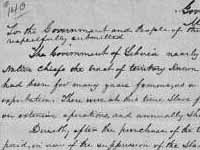
President Roberts Seeks American Support |
In this 1849 letter, President Joseph Jenkins Roberts of Liberia
appeals to the government and people of the United States for aid
in purchasing the territory of Gallinas, enabling Liberia to
control the West-African coast from Sierra Leone to Cape Palmas. As
incentive, Roberts boasts of the eradication of the slave trade in
territories recently acquired by Liberia and points out that adding
Gallinas would enable the republic to keep the whole coast "free
from the demoralizing and wilting influence of the Slave trade."
[Letter from President Joseph Jenkins Roberts of Liberia], May 19,
1849
Holograph
American Colonization Society Papers
Manuscript Division (11)
|
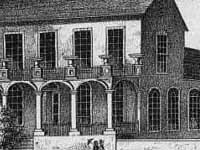
American Architectural Influence in Liberia |
In many respects, emigrants to Liberia re-created an American
society there. The colonists spoke English and retained American
manners, dress, and housing styles. Affluent citizens constructed
two-story houses composed of a stone basement and a wood-framed
body with a portico on both the front and rear, a style copied from
buildings in the southern American states from which most of the
emigrants came. Liberia's president lived in a handsome stone
mansion that resembled a southern plantation house.
"President Roberts's House, Monrovia"
Philadelphia: Wagner & McGuigan's, ca. 1850
Lithograph
Prints and Photographs Division (12)
|
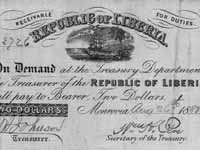
Liberian Currency |
Like the United States, Liberia used dollars and cents as its units
of currency. Reflecting the many inhabitants engaged in
agriculture, early Liberian currency pictured farmers and farm
animals. Later currency included a ship and palm trees like those
on the national seal. During the 1830s, the Maryland Colonization
Society, which had broken away from the ACS, ran its own colony
call "Maryland in Liberia" and issued its own currency. The colony
joined the Republic of Liberia in 1857.
[Liberian currency from the 1830s to the 1880s]
Currency
American Colonization Society Papers
Manuscript Division (13)
|
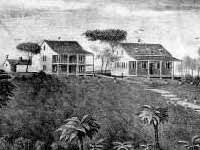
Mission at Cape Palmas |
Cape Palmas, founded in 1834, was the original settlement of the
Maryland Colonization Society, which purchased the peninsula with
muskets, powder, cloth, pots, beads, and other items of trade. The
peninsula became the site of three missions, established to
Christianize and civilize the native Africans. Known as "Mount
Vaughan," the Episcopal mission educated many members of Liberia's
indigenous tribes.
"Protestant Episcopal Mission, Cape Palmas, West Africa," ca. 1850s
Woodcut
Prints and Photographs Division (14)
|
![Grand Bass[u]a Settlements](images/bassua0.jpg)
Grand Bass[u]a Settlements |
Fishtown was a settlement in the Grand Bass[u]a area of Liberia, south
of Monrovia, near the St. John's River. In June 1835, one of the
bloodiest episodes in early Liberian history occurred at the nearby
Grand Bass[u]a settlement, where unarmed African-American settlers
were massacred by native Africans upset by disruption of the local
slave trade. A month later, militiamen from Monrovia attacked the
area's African villages. A treaty in November 1835 bound African
King Joe Harris to submit future disputes to the colonial
authorities at Monrovia and to pay for property destroyed in the
massacre.
"Fish Town at Bassua, Liberia"
Watercolor
Prints and Photographs Division (15)
|
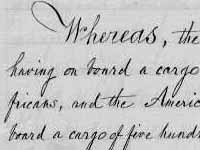
Settlement of Recaptured Slaves in Liberia |
Congress made the importation of slaves into the United States
illegal in 1808. In 1819, Congress passed an "Act in addition to
the acts prohibiting the Slave Trade." This act authorized the
president to send a naval squadron to African waters to apprehend
illegal slave traders and appropriated $100,000 to resettle
recaptured slaves in Africa. At various times, the ACS entered into
agreements with the U.S. government to settle these rescued victims
of the slave trade in Liberia. By 1867, more than 5,700 people had
come to Liberia under this program.
[Agreement to take recaptured slaves to Liberia], 1860
American Colonization Society Papers
Manuscript Division (16) |
![[First President of Liberia]](images/joseph0.jpg)
![[First Lady of Liberia]](images/jane0.jpg)




![Grand Bass[u]a Settlements](images/bassua0.jpg)

![[Previous]](prev.gif)
![[Next]](next.gif)
 Library of Congress
Library of Congress